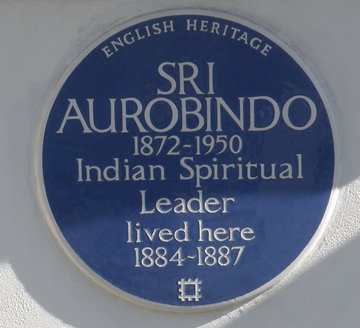
Aravinda Ackroyd Ghose
‐
Anti-colonialist, Hindu revivalist and poet
Other names
Sri Aurobindo
Aurobindo Ghose
Place of birth
Date of arrival to Britain
Location(s)
Talgarth Street
Hammersmith
London
W14 9DJ
United Kingdom King's College, Cambridge
CB2 1ST
United Kingdom
Place of death
Pondicherry, India
Date of time spent in Britain
1879–93
About
Although best known for his behind-the-scenes leadership of the Swadeshi protests against the partition of Bengal (1905–8), the anti-colonialist and Hindu revivalist Aravinda Ackroyd Ghose was a pioneering Indian poet in English in the 1890s. After his return to India, he published a collection of lyric poems, Songs to Myrtilla (1895), written while in England, and narrative poems based on Indian legends, Urvasie (1896) and Love and Death (1899). At the same time he embarked on a sustained critique of the reformist Indian National Congress (INC), carried out in journal articles.
The son of a medical doctor, Ghose was brought to England in 1879 and left by his parents, with his two brothers, to study. He was educated privately at St Paul’s School, and then at King’s College, Cambridge as a classics scholar. His brother was Manmohan Ghose, an 1890s poet associated with the Rhymers' Club (known for its aestheticism) and friend to English critic Laurence Binyon. Ghose passed the Indian Civil Service examination with Distinction but was unable to take up a position as he failed to appear for the riding test. He returned to India in 1892 whereupon he took up a post at Baroda College.
Back in India, Ghose became involved in Indian politics with his brothers. From around 1902 he had contacts with 'revolutionaries' in Bengal and was involved in a number of bomb plots against the British. Ghose was also a friend to Sister Nivedita (Margaret Noble), though this contact was forged in India in the early 1900s. He became editor of Bande Mataram in 1906. In 1910 Ghose left Calcutta for Pondicherry, to flee prosecution, and became devoted to the practice of yoga. He became a spiritual leader and built up a popular ashram in Pondicherry, retiring from public view around 1926.
Manmohan Ghose (brother), Margaret Noble (contact in India in the early 1910s).
Bande Mataram: Early Political Writings (Pondicherry, 1972)
On Himself (Pondicherry, 1972)
As well as the works mentioned, 1900s articles for Bande Mataram, which he edited; various yoga texts after 1910; and also translations, criticism and spiritual writings.
Boehmer, Elleke, Empire, the National and the Postcolonial (Oxford: Oxford University Press, 2002)
Gandhi, Leela, Affective Communities (Delhi: Permanent Black, 2006)
Heehs, Peter, Sri Aurobindo: A Brief Biography (Delhi: Oxford University Press, 1989)
Heehs, Peter, Nationalism, Terrorism and Communalism (Oxford: Oxford University Press, 1998)
Heehs, Peter, The Lives of Sri Aurobindo (New York: Columbia University Press, 2008)
Iyengar, K. R. S., Sri Aurobindo: A Biography and a History (Pondicherry: Sri Aurobindo Ashram, 1985)
Purani, A. B., Sri Aurobindo in England (Pondicherry: Sri Aurobindo Ashram, 1956)
Purani, A. B., The Life of Sri Aurobindo (Pondicherry: Sri Aurobindo Ashram, 1978)
See also Anita Desai’s novel, Journey to Ithaca, a fictionalization of the mother’s story
Archive at Sri Aurobindo Ashram, Pondicherry
Sri Aurobindo Collection, Baroda RO, Baroda
Image credit
Photo by F. C. Stadtler
